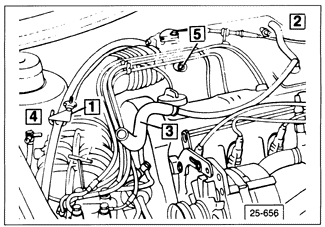|
For best results, idle speed should always be checked and adjusted along with ignition timing, differential pressure regulator current, and idle mixture (% CO), as these factors can all affect idle speed, driveability and emissions. First make sure ignition timing is properly adjusted. See IGNITION. With ignition timing properly adjusted, check and adjust idle speed, differential pressure regulator current and idle mixture, repeating the adjustments until all are simultaneously within specifications. See 6.1 Air Flow Measurement and Fuel Metering for information on the differential pressure regulator, and 6.7 Idle Specifications. If the equipment necessary to accurately perform these checks and adjustments is not available, we suggest turning the job over to an authorized Volkswagen dealer or other qualified repair shop. In a properly equipped shop, these checks and adjustments can be made quickly, accurately, and at reasonable cost. When adjusting idle, the following requirements apply:
Connect a tachometer according to the instrument manufacture's instructions in order to accurately measure rpm. The ignition signal lead from the tachometer should be connected to terminal 1 of the coil.
Make sure that the auxiliary air regulator is fully closed. If it is, engine rpm should not change when the hose to the auxiliary air regulator is pinched shut. If the rpm drops when the hose is pinched, the regulator should be checked as described in 5.4 Idle Speed. Fig. 6-29 shows the temporary set-up necessary for idle speed adjustment. Pinch shut the hose leading from the idle speed boost valve(s). Disconnect the crankcase ventilation hoses from the intake manifold and the air flow sensor. Remove the charcoal canister line "T" fitting from the air flow sensor boot and turn it to insert the side with the 1.5 mm (.059 in.) restrictor hole. If the car is not equipped with the "T" fitting, remove the hose and fit a restrictor plug with a 1.5 mm (.059 in.) hole. Such a plug is available from Volkswagen. Ask for part no. 026 133 382D.

Idle speed should be between 800 and 1000 rpm. If not, adjust it to 900 ± 30 rpm by turning the idle air bypass screw-clockwise to decrease idle speed, and counterclockwise to increase it. When all adjustments are complete, restore the hose and fitting connections described in Fig. 6-29 to their original configurations. |